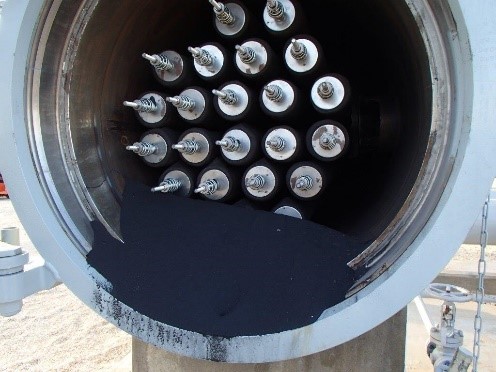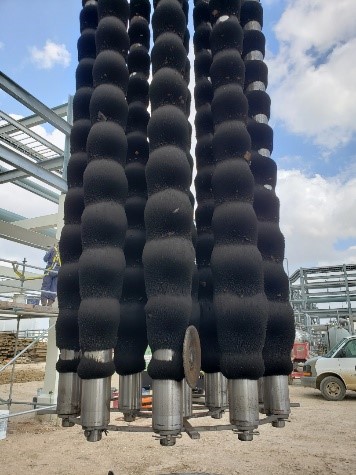“Black PowderTM” (black powder) contamination is a widely used term for a highly pervasive particulate contamination found in all hydrocarbon facilities and pipelines, water systems, petrochemical powders, and other fluid and gas systems. It has many other names, such as black dirt, sludge, shoe polish, brown dirt, rouge and black sand, among others. It typically has a black or dark gray appearance but can also be brown or dark red depending on its specific composition. Black powder can be dry when found in gas applications, such as in natural gas systems, or wet and ‘sludgy’ in hydrocarbon fluid, crude or amine applications. It primarily consists of ferrous compounds such as iron sulfide and iron oxide, as well as other elements (and related minerals) such as phosphorous, aluminum, vanadium, manganese, sodium, calcium, sulfur, chlorides, silica, carbonates, sand and many others. Its size can range significantly, from over 500 microns to sub-1 micron levels. Particle counts often increase in the sub-50 micron range, and particularly in the sub-10 micron range. All too often, its presence and negative impacts are accepted by industry as a cost of doing business.
Figure 1. Conventional filter system overloaded with black powder contamination.
Figure 2. Black powder captured on a magnetic separator system.
The initial formation of black powder – particularly the iron sulfide (FeS) component – starts with H2S, water (H2O) and iron (Fe), as well as carbon dioxide (CO2). Microbes, including both sulfate-reducing and acid-producing bacteria, are key contributors to the formation of corrosion-causing sulfur compounds such as hydrogen sulfide (H2S), both in the well and in pipeline systems. The interaction between H2S, even at very low concentrations, and carbon steel in the presence of water, will cause the formation of FeS compounds. While some FeS formation occurs downhole in wells, the primary source of the contamination is in pipelines, and in upstream and midstream facilities where microbes contact iron, such as in carbon steel in facility and pipeline material. The degradation of this pipeline material by microbes (as well as erosive influences) can also be evidenced indirectly by the presence of other elements in black powder contamination sampling and analysis, such as manganese, copper and silicon.
Figure 3. Black powder particulate under microscope.
FeS can take on many mineral forms, such as Mackinawite (FeS), Pyrite (FeS2), Greigeite (Fe3S4) and Pyrrotite (Fe0.879S), most of which are typically found in a compositional analysis of black powder. The formation of any of these FeS compounds can be affected by the presence of the other FeS compounds, as well as pressure and temperature changes. Another key aspect of black powder is its reactivity to oxygen, either bonded in compounds and minerals or as O2, as FeS will oxidize into iron oxide (FeO) compounds in the presence of oxygen. In the case where Fe, O2 and H2O are present, without H2S, FeO will form, creating various iron compounds, including magnetite.
The conversion of FeS to FeO is an exothermic reaction and a pyrophoric process, therefore treatment of iron sulfide compounds is required to reduce the potential combustion hazard (ie. introduction of water or potassium permanganate). The process of contamination sampling requires that the sample has limited or no exposure to oxygen in order to preserve the FeS compounds for proper identification. By not eliminating or minimizing the exposure of black powder to oxygen, samples may incorrectly identify black powder as largely consisting of FeO, rather than correctly identifying it as FeS, which can create safety issues, particularly in the presence of hydrocarbons.
In addition to FeS and FeO, black powder also consists of other forms of particulate, including elements such as magnesium, titanium, vanadium, molybdenum, calcium, sulfur, phosphorous, silica and zinc, as well as minerals and compounds such as sodium chloride, potassium chloride, calcium carbonate, zinc sulfide and many others. The presence of these types of contaminants should not come as a surprise, as they form and are introduced during hydrocarbon production, treating, processing, transport and storage.
Figure 4. Black powder build up in piping.
Once in a system, black powder will continue to accumulate through erosion and abrasion. In relation to carbon steel, the iron compounds in black powder are particularly hard. Black powder particles are prone to breakage into smaller, highly angular shapes that result in a very abrasive contaminant that causes pipeline wear and pitting and the erosion of coatings and passivating layers. As it is prone to shear into smaller particle sizes, black powder particle counts in the sub-10 micron size range can be significant. Management of particles at 10 microns and below can be problematic and expensive to address with conventional filtration methods.
The effects of black powder on hydrocarbon facilities are well-noted. It has many negative influences, such as:
- wall loss and excessive wear in pipelines,
- more frequent pigging in pipelines due to accumulation,
- premature wear to compressors, pumps and seals (including bypassing seals into lubrication systems),
- wear on valves and plugging of meters,
- displacement of storage volumes in tankage,
- reduction of product quality,
- infiltration into heat exchangers and reboilers,
- plugging off conventional filtration systems,
- increase in power/fuel requirements to maintain flows and pressures, and
- upsets to gas treating systems such as amine and glycol and related increases to power/fuel and chemical costs.
To prevent black powder from accumulating in systems and equipment, and allowing it to continue downstream, the goal for facility and pipeline operators should be first to eliminate the conditions for its development through proper root cause analysis and secondly to eliminate its presence as early as possible in the hydrocarbon value chain. Managing black powder requires knowledge and acceptance of its formation process and presence, and a plan and equipment to remove it.
For more information, or to download the report, please visit: blackpowdersolutions.com
Share This:





 CDN NEWS |
CDN NEWS |  US NEWS
US NEWS 



































Canada’s Advantage as the World’s Demand for Plastic Continues to Grow